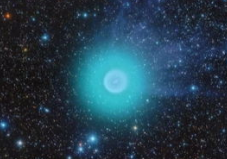- 阅读
- 阅读
- 技巧
- 百科
- 试题
- 文化
- 技能
Tailless comets could threaten Earth, but they also offer an explanation of the solar system's earliest days.
无尾彗星可能对地球构成威胁,但也为太阳系的早期形成提供了解释。
NASA's dart mission was an impressive success.
NASA的“飞镖”任务取得了重要成功。

Another of the reasons for this lack of notice is that, having fallen so far through the Sun's gravitational field to get there, Oort-cloud objects are, by the time they reach the inner solar system, travelling fast.
无法观测到无尾彗星的另一个原因是,奥尔特云中的物质从极远处穿越太阳引力场才到达太阳系内部,它们到达时,会处于一个快速移动的状态。
If one hit Earth it would have an impact velocity of 50-70km per second, about three times that of a nearby asteroid.
如果无尾彗星撞上地球,它的撞击速度将达到每秒50-70公里,大约是地球附近小行星速度的三倍。
And smaller rocks with such velocities (and therefore presumably of Oort-cloud origin) do enter the atmosphere from time to time.
这种高速的(因此推测它们可能来自奥尔特云)小块岩石确实时不时地进入大气层。
One such was observed, as Denis Vida of the University of Western Ontario told the meeting, by a programme called the Meteorite Observation and Recovery Project, which watches for meteors over Alberta, in western Canada.
正如西安大略大学的丹尼斯·维达在会上所说的那样,观测加拿大西部艾伯塔省上空的“陨石观测和回收项目”就观测到了这样的流星。
The object in question weighed about 2kg - too small to reach Earth's surface.
该流星重约2公斤,质量太小,无法到达地球表面。
Instead, it burned up in the atmosphere as a fireball.
因为它在大气层中就会像火球一样燃烧,烧成灰烬。
But its velocity meant it came closer to the ground than most fireballs of that size, ending its run at a height of just over 46km, whereas 70-80km is normal.
但它的高速运动意味着它能比大多数类似大小的火球更接近地球表面,结束飞行的地点在略高于地面46公里的高度,而正常情况下,流星结束飞行的距离大约是距地面70-80公里。
However, penetration that far into the atmosphere also meant it must have been a lump of solid rock, rather than the fragile icy conglomerate that standard comets are made of.
然而,如此深入大气层也说明它一定是一块坚硬的岩石,而不是和标准的彗星一样由脆弱的冰块组成。
A kitten, then, of a Manx comet.
那么,这是一只马恩岛猫彗星的“小猫”。
Intrigued, Dr Vida searched the astronomical literature for similar fireballs.
出于好奇,维达博士搜索了天文文献中出现的类似火球。
He found two others: one seen in the 1980s by the Albertan instrument's predecessor; the second noticed over the Czech Republic in the 1990s.
他发现了两个:一个是在20世纪80年代用阿尔伯塔天文仪器的前身观测到的;另一个是在20世纪90年代在捷克共和国上空发现的。
He then compared the two examples detected over Alberta with the number of high-speed fireballs seen by the same instruments that disintegrated in the upper atmosphere, and were thus, presumably, made of cometary material rather than solid rock.
然后,他将在阿尔伯塔省探测到的两个例子与利用相同仪器观测到的在高层大气中解体的高速火球的数量进行了比较。由于后者在高层大气中解体,推测其构成与一般彗星相同,不是坚硬的岩石构成的。
This gave him a rough estimate (about 6%) of the amount of rocky, as opposed to cometary, material in the steady rain that is falling from the Oort cloud - and thus of the ratio of rocks to conglomerates in that cloud.
这让他得到了一个粗略的估计数据,即从奥尔特云不断坠入太阳系内部的岩石固体物质约占彗星总体的6%,由此可知,奥尔特云中岩块占云团总体的比重也约为6%。
This figure, which matches what other researchers have concluded is the proportion of comets which are of the Manx variety, matters to those interested in the formation of the solar system.
这个数字与其他研究人员得出的马恩岛猫彗星占彗星总体的比重相一致,这个数字也对那些对太阳系形成感兴趣的人来说十分重要。
They need to explain how such substantial quantities of solid rock - a substance thought likely to have formed only near the Sun, since it requires the stuff of the primordial solar nebula to have been concentrated into large objects, then melted and differentiated - ended up so far away from its birthplace.
因为需要原始太阳星云凝聚以形成大体积的物质,然后熔化和分异,陨石被认为是一种只可能在太阳附近形成的物质,对此,研究人员需要解释,如此大量的固体石块最终是如何来到离它的诞生地如此遥远的地方的。
As it happens, this mystery is the inverse of another, which is that there is less rocky material than expected between the orbits of Earth and Jupiter, the part of the solar system occupied by Mars and the asteroid belt.
碰巧的是,这个谜团与另一个谜团相反,那就是在地球和木星的轨道之间,即太阳系中由火星和小行星带占据的部分岩石物质比预期的要少。
One explanation put forward for this is the “Grand Tack” hypothesis, that a juvenile Jupiter moved temporarily closer to the Sun, thus disturbing the asteroid belt and sending much of its contents into the Sun, into outer space or into the Oort cloud.
对此提出的一种解释是“大迁徙”假说,即木星形成早期曾暂时向靠近太阳的方向移动,扰乱了小行星带,并将小行星带内的大部分物质送入太阳、外层空间或奥尔特云。
Manx comets and their kittens suggest this is exactly what occurred.
马恩岛猫彗星和它们的小猫表明,这些假说是成立的。
Just hope that one of those returning exiles does not pay Earth a visit on its way.
只希望那些归来的流放者中不会有哪一颗在回家的路上造访地球。
来源:经济学人
参与评论